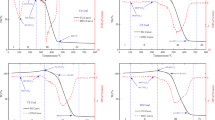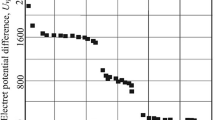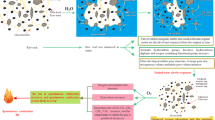Abstract
Improved understanding of the physical state of coal is needed to better characterize, modify and utilize this abundant source of energy. In spite of extensive research in this area for well over half a century, the level of understanding has been poor. Here, new substantive evidence clarifying the macromolecular states of coal is presented. The approach involved studying changes in the optical anisotropy of raw and solvent-swollen thin section samples of a bituminous coal. It was found that the natural optical anisotropy was completely relaxed on immersion of the coal in pyridine. From changes in the optical anisotropy induced by pressure, the solvent-swollen coal was determined to be a cross-linked rubber and its macromolecular chain segments were found to have substantial mobility. It appears that pyridine and some other good swelling agents relax essentially all of the secondary bonding in the coal. On the other hand, raw coal and coal immersed in water, various hydrocarbon solvents and other poor swelling agents were determined to be macromolecular plastics.
This is a preview of subscription content, access via your institution
Access options
Subscribe to this journal
Receive 51 print issues and online access
$199.00 per year
only $3.90 per issue
Buy this article
- Purchase on Springer Link
- Instant access to full article PDF
Prices may be subject to local taxes which are calculated during checkout
Similar content being viewed by others
References
Peters, K. & Cremer, W. Z. angew. Chem. 47, 576–578 (1943).
Howard, H. C. J. phys. Chem. 40, 1103–1112 (1936).
Hirst, W. in Proc. Conf. Ultra-fine Structure of Coals and Cokes, BCURA, 38 (Lewis, London, 1944).
Boddy, R. G. H. B. in Proc. Conf. Ultra-fine Structure of Coals and Cokes, BCURA, 336–341 (Lewis, London, 1944).
Gregory, H. R. Trans. Instn Chem. Engrs. 40, 241–251 (1962).
Newman, P. C. Brit. J. appl. Phys. 6, 348–349 (1955).
Sanada, Y. & Honda, H. Fuel 45, 295–300 (1966).
Treloar, L. R. G. The Physics of Rubber Elasticity 3rd edn, 60 (Clarendon, Oxford, 1975).
Berkowitz, N. Proc. 11th Biennial Lignite Symp. San Antonio, Texas, Vol. 1, 414–422 (1981).
Larsen, J. W. & Kovac, J. ACS Symp. Ser. 71, Ch. 2 (1978).
Bangham, D. H. & Maggs, F. A. P. in Proc. Conf. Ultra-fine Structure of Coals and Cokes, BCURA, 118 (Lewis, London, 1944).
Davidson, R. M. Molecular Structure of Coal, 20–21 (IEA Coal Research, London, 1980).
Brenner, D. Proc. Int. Conf. Coal Sci. 163–168 (Gluckauf, Essen, 1981).
Brenner, D. Preprints of the Fuel Chemistry Division, 244–253 (ACS National Meeting, 1982).
Teichmüller, M. & Teichmüller, R. in Stach's Textbook of Coal Petrology, 2nd edn, 47 (Gebriider Borntraeger, Berlin, 1975).
Hartley, G. S. Trans. Faraday Soc. 45, 822–824 (1949).
Author information
Authors and Affiliations
Rights and permissions
About this article
Cite this article
Brenner, D. The macromolecular states of solvent-swollen and dry coal. Nature 306, 772–773 (1983). https://doi.org/10.1038/306772a0
Received:
Accepted:
Issue Date:
DOI: https://doi.org/10.1038/306772a0
Comments
By submitting a comment you agree to abide by our Terms and Community Guidelines. If you find something abusive or that does not comply with our terms or guidelines please flag it as inappropriate.



